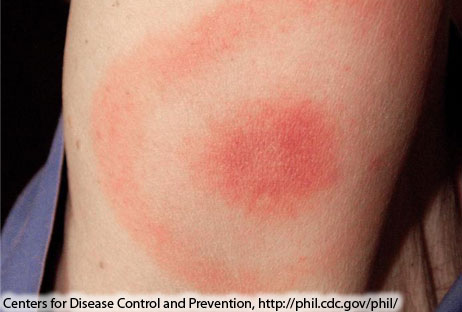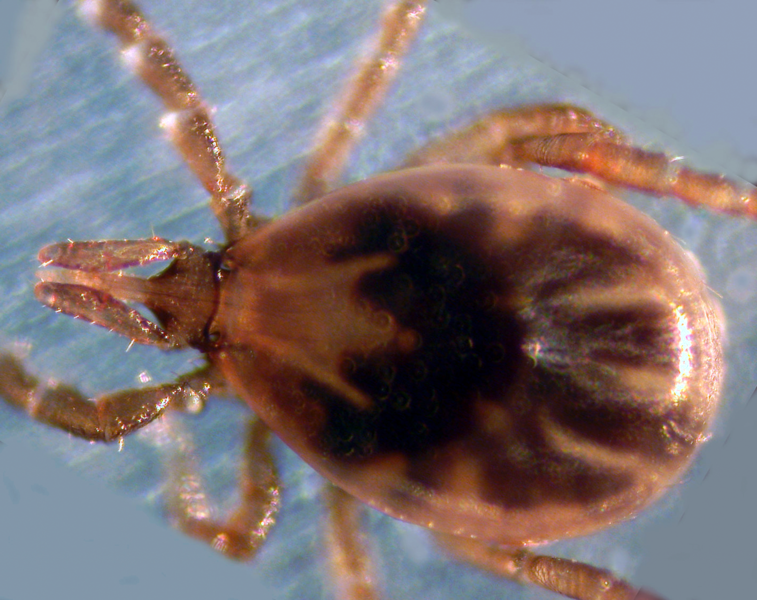Sandbox : anmol: Difference between revisions
Jump to navigation
Jump to search
No edit summary |
|||
| Line 3: | Line 3: | ||
'''To go back to Lyme disease main page, click [[Lyme disease|here]]''' | '''To go back to Lyme disease main page, click [[Lyme disease|here]]''' | ||
{{CMG}}; {{AE}} | {{CMG}}; {{AE}}{{Anmol}} | ||
==Overview== | ==Overview== | ||
Revision as of 16:43, 7 August 2017
To go back to Lyme disease main page, click here
Editor-In-Chief: C. Michael Gibson, M.S., M.D. [1]; Associate Editor(s)-in-Chief: Anmol Pitliya, M.B.B.S. M.D.[2]
Overview
- Lyme disease is a condition commonly caused by bite of a tick infected with Borrelia burgdorferi.
What are the symptoms of Lyme disease?
|
 |
- Later Signs and Symptoms (days to months after tick bite):
- Severe headaches and neck stiffness
- Multiple EM rashes on other areas of the body
- Arthritis with severe joint pain and swelling, particularly the knees and other large joints.
- Facial palsy (loss of muscle tone or droop on one or both sides of the face)
- Intermittent pain in tendons, muscles, joints, and bones
- Heart palpitations or an irregular heart beat (Lyme carditis)
- Episodes of dizziness or shortness of breath
- Inflammation of the brain and spinal cord
- Nerve pain
- Shooting pains, numbness, or tingling in the hands or feet
- Problems with short-term memory
- Severe headaches and neck stiffness
Notes
What causes Lyme disease?
|
 |
Who is at highest risk?
Individuals who spend time outdoors and/or have pets that go outdoors in endemic regions are at risk for tick-borne disease. [1]
Exposure to ticks
- Individuals with frequent exposure to dogs and who reside near wooded areas or areas with high grass may also be at increased risk of tick-borne infection.
- Individuals with outdoor occupations and who work outside with bare or exposed skin are at a high risk of contracting Lyme disease.
- Failing to remove a tick as soon as you see it on your skin (the longer a tick is attached to your skin, the greater your risk of developing Lyme disease) also increases risk of developing Lyme disease.[2]
Endemic Regions
- About 95% of all reported cases are confined to 14 states including Connecticut, Delaware, Maine, Massachusetts, Minnesota, New Hampshire, New Jersey, New York, Pennsylvania, Rhode Island, Vermont, Virginia, and Wisconsin.[3][4]
- Any individual traveling or living within these five geographic areas including New England, Mid-Atlantic, East-North Central, South Atlantic, and West North-Central is at a heightened risk of exposure to Lyme disease.
Seasonal Variation
- The majority of Lyme disease cases are reported during the summer months of May to August.
- Case incidence increases in May, peaks in June and July, and tapers off in August.
Rarer forms of Transmission
- Cases of blood transfusion and organ transplantation have been recorded as methods of transmission but this is a rare mode of transmission. [5]
Diagnosis
- Following points should be taken into consideration in order to make a diagnosis of Lyme disease:
- A history of exposure to potentially infected ticks, especially in areas of the country known to have Lyme disease.
- Symptoms, including physical findings such as the characteristic rash.
- Results of blood tests that check for antibodies to the bacterium that causes Lyme disease.
When to seek urgent medical care?
- Lyme disease is rarely fatal.
Treatment options
- According to CDC, patients treated with antibiotics in the early stages of the infection usually recover rapidly and completely.
- Antibiotics commonly used for oral treatment include doxycycline, amoxicillin, or cefuroxime axetil (Ceftin).
- Patients with certain neurological or cardiac forms of illness may require intravenous treatment with drugs such as ceftriaxone or penicillin.
Where to find medical care for Lyme disease?
- In this section you can provide links for reputable places that the patient can find good treatment for there condition.
Prevention
- Educate yourself about Lyme disease, and try not to get bitten by ticks. More specifically:
- Avoid wooded, brushy, and grassy areas, especially in May, June, and July. (Contact the local health department or park/extension service for information on the prevalence of ticks in specific areas.)
- Wear light-colored clothing so that you can see ticks that get on you.
- Wear long pants and long-sleeved shirts.
- Wear shoes that cover the entire foot. Tuck pant legs into socks or shoes, and tuck shirts into pants.
- Wear a hat for extra protection.
- Spray insect repellent containing DEET on clothes and exposed skin other than the face, or treat clothes with permethrin, which kills ticks on contact.
- Walk in the center of trails to avoid brush and grass.
- Remove your clothing, and wash and dry them at high temperatures after being outdoors.
- Do a careful body check for ticks after outdoor activities.
- If a tick is attached to you, remove it!
- Using tweezers, grasp the tick close to the skin, pull straight back, and avoid crushing the tick's body.
- Save the tick for possible identification by a doctor or the local health department.
What to expect (Outlook/Prognosis)?
- For early cases, prompt treatment is usually curative.
- However, the severity and treatment of Lyme disease may be complicated due to:
- Late diagnosis
- Failure of antibiotic treatment
- Coinfection with other tick-borne diseases including Ehrlichiosis and Babesiosis
- Immune suppression in the patient
- Some patients with Lyme disease have fatigue, joint and/or muscle pain, and neurocognitive symptoms persisting for years despite antibiotic treatment.
- Patients with late stage Lyme disease have been shown to experience a level of physical disability similar to that seen in congestive heart failure.
- Though rare, Lyme disease can be fatal.
Possible complications
- Late Lyme disease can cause long-term joint inflammation (Lyme arthritis) and heart rhythm problems. Brain and nervous system problems are also possible, and may include:
- Decreased concentration
- Memory disturbances
- Nerve damage
- Numbness
- Pain
- Paralysis of the face muscles
- Sleep disorders
- Vision problems
Sources
- https://medlineplus.gov/lymedisease.html
- https://www.cdc.gov/lyme/index.html
- https://www.fda.gov/ForConsumers/ConsumerUpdates/ucm049298.htm
- Place your patient page in the patient information category as well as any other doctor categories the condition may fit into. To place a category onto a page, use the following code:
- [[Category:Patient information]]
- As with all WikiDoc pages, create hyperlinks for key words and diseases. However, make sure that the hyperlinks link to other patient's information pages and not to regular WikiDoc pages.
- Example: Heart failure should be linked to [[Congestive heart failure (patient information)]] and not to [[Heart failure]].
- ↑ General Information (2015). http://www.cdc.gov/ticks/index.html Accessed on December 30, 2015
- ↑ "Lyme disease: All - MayoClinic.com". Retrieved 2013-03-14.
- ↑ "Lyme disease data tables | Lyme Disease | CDC".
- ↑ "Data and Statistics | Lyme Disease | CDC".
- ↑ Lyme disease transmission. Centers for Disease Control and Prevention. http://www.cdc.gov/lyme/transmission/index.html Accessed February 9, 2016.